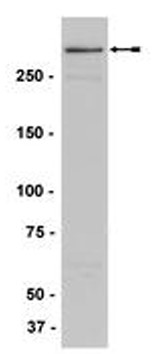Anti-MLL N-Terminus Antibody (34041)
Anti-MLL N-Terminus Antibody (34041)
Product No.: 34041
- -
- -
Clone N4.4 Target MLL.N Formats AvailableView All Product Type Monoclonal Isotype Mouse IgG1 Applications IP , WB |
Data
- -
- -
Antibody DetailsProduct DetailsReactive Species Human ⋅ Mouse Host Species Mouse Immunogen Maltose-binding fusion protein containing MLL amino acids 161-356 (Uniprot #Q03164). Product Concentration Lot Specific Formulation This monoclonal antibody is formulated in phosphate buffered saline (PBS) pH 7.2 - 7.4 with no carrier protein or preservatives added. State of Matter Liquid Product Preparation Antibodies are purified by a multi-step process including the use of protein A or G to assure extremely low levels of endotoxins, leachable protein A or aggregates. Storage and Handling Upon initial thawing, appropriately aliquot and store at -80°C. For long-term storage, keep at -80°C. Avoid repeated freeze-thaw cycles. Country of Origin USA Shipping Next Day 2-8°C Applications and Recommended Usage? Quality Tested by Leinco Immunoblotting: use at 2ug/mL. A band of ~300kDa is detected.
Immunoprecipitation: use 2-10ug per 500ul (1-3mg/ml) of cell lysate. Positive control: K562 cell lysate. These are recommended concentrations. Endusers should determine optimal concentrations for their applications. Each investigator should determine their own optimal working dilution for specific applications. See directions on lot specific datasheets, as information may periodically change. DescriptionDescriptionSpecificity This antibody recognizes human and mouse MLL (N-terminus). Background MLL (Mixed Lineage Leukemia) is a proto- oncogene that is mutated in a variety of acute leukemias. MLL is proteolytically processed into 2 fragments, MLLN and MLLC, that display opposite transcriptional properties. Processed MLLN and MLLC associate with each other via N-terminal and C-terminal intramolecular interaction domains. MLL processing occurs rapidly after translation and is followed by phosphorylation of MLLC. MLLN displays transcriptional repression activity, whereas MLLC has strong transcriptional activation properties. Leukemia-associated MLL fusion proteins lack the MLL processing sites, do not undergo cleavage, and are unable to interact with MLLC. These observations suggest that posttranslational modifications of MLL may be involved in regulating MLL activity as a transcription factor, and this aspect of its function is perturbed by leukemogenic fusions. NCBI Gene Bank ID UniProt.org Research Area Cancer Research References & Citations1) Yokoyama A et al. 2002 Blood 100: 3710-3718. 2) Yokoyama A et al. 2005 Cell 123: 207-218. Technical ProtocolsCertificate of Analysis |



